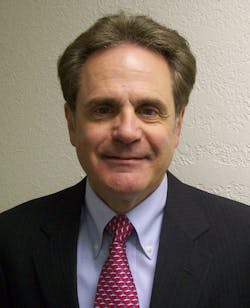The New Mexico Health Information Collaborative (NMHIC) is the statewide health information exchange (HIE) network and the name of the collaborative that supports the network. Supported and operated by the non-profit organization LCF Research, the NMHIC HIE network currently has access to patient information at 14 hospitals, two major medical groups, and three independent laboratories. NMHIC has been in production providing electronic lab results and patient encounter information from hospital emergency departments to the New Mexico Department of Health (NMDOH) since June 2010.
At NMHIC, patient information from each healthcare provider is stored on edge servers at each provider’s facility. Providers have been adding information to their NMHIC edge servers for some time. Every time new patient information is stored on an edge server, a message is sent to the NMHIC master person index (MPI) to determine whether that information is from an existing patient or a new patient. If the new information is for an existing patient, the MPI will link the new information to an existing patient identity; but if it is a new patient, the MPI will create a new patient identity.
NMHIC now has more than 1.3 million unique patient identities in the MPI, out of a total state population of 2 million. This design, where patient information is stored at each provider’s facility, while the master person index and record locator service are centrally operated at the LCF Research data center, is called a hybrid HIE architecture, says Craig Hewitt, chief information officer (CIO) of NMHIC. Hewitt recently spoke to HCI Assistant Editor Rajiv Leventhal about challenges, HIE trends, and how the government can better enable health information exchange. Below are excerpts from that interview.
What is the NMHIC currently working on?
In the last year, we have expanded into a much broader range of services. We are now ultimately targeting patient populations, with tools around case management, chronic disease management, using business intelligence tools to understand and model information with the ability for intra-exchange as well as inter-exchange. We are now expanding even beyond that so we have the capbility for consumers to be engaged in that decision process with the use of our patient portal and a number of other satellite services that are focused on more of a community health exchange. The patient information displayed on the web portal is gathered from all of the healthcare facilities that have previously treated the patient, and that are part of the NMHIC network. All of the information from the patient’s previous visits is integrated into a Summary Patient Record for easier clinician review. This capability makes care coordination easier, faster and less expensive.
Recently, we chose an HIE platform [hosted by the New Zealand-based] Orion Health (with U.S. headquarters in Santa Monica, Calif.) to power the statewide exchange and expand the capabilities it offers to healthcare providers across New Mexico. We are in the midst of migrating from our current platform and will transfer about one million MPI records to the Orion HIE. With the enhanced features that Orion Health HIE offers, users will not only have access to the latest patient information, they’ll have the tools needed to drive improvements in care throughout the state. You can track what you want to know about your patients, whether they’ve been to other clinics, hospitals, the emergency room, if they have been discharged. You can automatically set yourself inside that circle of information so you know what’s going on. In the prior world, that was really difficult to do. That’s the big push that we hear from providers—it’s a big demand. The ability to take a look at what’s happening across multiple cases of like diseases, be able to analyze that, and put in best practices based on what you’re seeing—or even go target areas or groups that may not be at the level of providing care that they need to be—this wasn’t even on our radar screen years ago.
What are some of your most pressing challenges as CIO?
Well, contrary to popular belief, technology is actually the least of our concerns. Instead, the biggest barriers to our success are funding and patient consent. We currently receive funds through the Office of the National Coordinator (ONC) for Health Information Technology, the Agency for Healthcare Research and Quality (AHRQ), the New Mexico State Legislature, and community stakeholders. But federal funding is expected to diminish. In my opinion, there needs to be incentives for organizations to use the technology, which actually seems like an oxymoron, because by using it, it will make you more effective in providing quality care as well as providing value in saving costs in things you don’t need to do. But we need to give them some incentive to pay for it.
There is also a constant concern regarding who has access to my information. How should it be used? Some of that thinking will change, as we have capabilities in the digital world to give us even more [knowledge] about what is going on with that information. But we don’t have a universal standard that allows us to share information from an intra-perspective to an inter-perspective without having so many barriers in place, and that gives us problems. Also, providers worry about the insurers, wondering what they’re going to do with that information and if they’re going to tell them how to practice healthcare. Although a lot of that has changed with the accountable care organization (ACO) model now, there is still concern.
Additionally, in many cases in New Mexico, we’re dealing with the under-advantaged in rural geographic areas. The technology and services they need from a healthcare perspective are long and far between. Here, we are fortunate to be aligned with telemedicine and telehealth collaboratives. But we do have a high native population. The capabilities that exist in these areas are so diverse, so it’s hard to just wave your magic wand and put these things in.
So what can do the government do to better enable health information exchange?
That’s a question that the Centers for Medicare & Medicaid Services (CMS) recently asked in a request for information (RFI), specifically about how they could make changes relative to interoperability and advancing exchange. One of the components was the pricing incentives. If there was an incentive through CMS to use the service and get paid for it, I think that would be one huge barrier that would be removed. You’re seeing some of that across the country where that funding is done de facto through Medicaid. But if we could have that be more universal, you would see a rapid evolution of advancing interoperability and the exchange of information in this country. I am hopeful this can happen. It needs to be pushed through CMS and ONC, though. I think that it has a huge return with a minimal expense, and it needs to be pushed at all levels. I was hopeful when they sent out the RFI, and if you look at the comments across the 50 states, they’re pretty consistent for making a mandate for incentivized payments.
What are the keys to HIE sustainability?
You have to have all aspects of your partners involved, engaged, and understanding from the beginning. They have to become advocates for it, which can be difficult. You want to get into a situation where your consumers are evangelizing for your service, which isn’t easy, but is pivotal to making the exchange of information happen. You also need to understand what it is that the people who need that service want. You can’t be out there trying to provide services that have no value to the individuals who are receiving or providing care. You need to get engaged with all those different audiences. Know what their needs are and push it. That could have a very rewarding result.
In many cases, providing care and practicing medicine is more of an art than a standard. That’s evolving, but until it’s addressed, it makes it harder for us to use the information around clinical care in the most beneficial manner. For instance, if people have different methods for doing a lab result or documentation, it makes it harder for us to gather that information and normalize it to use it in a beneficial matter to see what’s really going on in healthcare.
Everyone sees the value of HIE—it makes perfect sense. The smaller you are, the more likely you are to be positive about using this service and have minimal concern about the economics of it. Being larger will mean different economies because you have higher volumes, so the cost of doing business will be higher. Larger organizations might also be concerned with the impact on their market and growth by sharing information about their patients. That sometimes can make our discussions difficult when talking about the true value of using our service. I wish there was a federal mandate, “thou shall use these services.” And there is meaningful use, but that’s not as much of a mandate as it is an option. But at the end of the day, while demands vary and could be extreme, this is the right thing to do and should have been put in place a long time ago.


